
 |
|
#1
|
|||
|
|||
|
I just bought this little girl because the vote was 100% for the 1945 Humber to remain untouched and the devil makes work for idle hands.
Does anyone have any info or photos of these in WW2 service? I have found many references to them being delivered in UK during the war in reasonably large numbers but no photos. I have not seen the van yet but the owner says it is ex-army and still painted army green (what is such a little tike doing in Australia, why would they bother importing it and more of its mates?) Lang  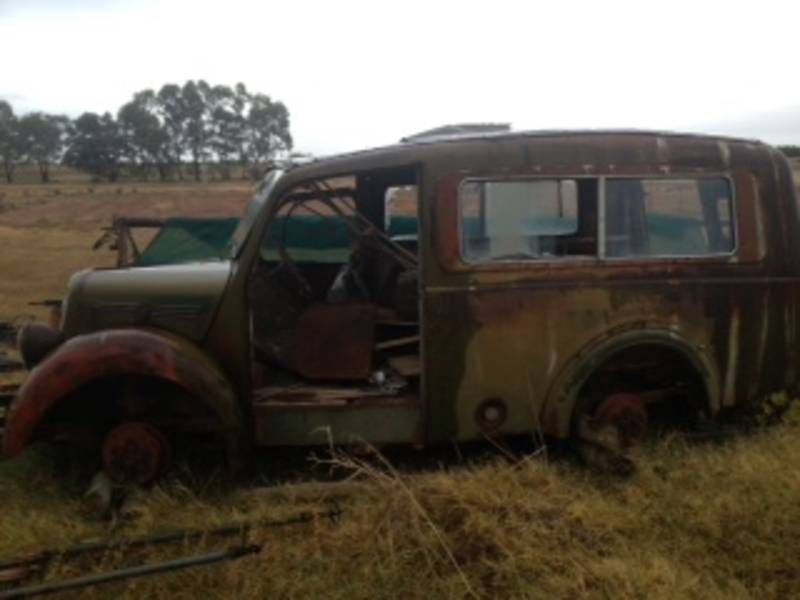 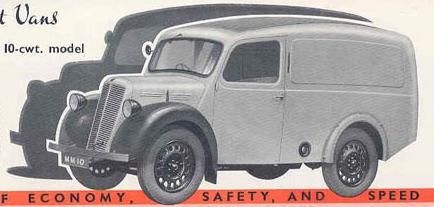 Economy, Safety and Speed? I suppose 30 mph is a speed! Last edited by Lang; 19-05-13 at 14:00. |
|
#2
|
||||
|
||||
|
Hi Lang,
The British Army did use some model Y vehicles, not sure about that standard body but there was an ambulance with a wider and taller body. A restored one comes out to shows over here. Regards Richard
__________________
Richard 1943 Bedford QLD lorry - 1941 BSA WM20 m/cycle - 1943 Daimler Scout Car Mk2 Member of MVT, IMPS, MVG of NSW, KVE and AMVCS KVE President & KVE News Editor |
|
#3
|
|||
|
|||
|
Yes, this is rare find.
Maybe, the following books will be useful for You to know, which versions were in use (note: I have not any connections with those sellers !): http://www.ebay.co.uk/itm/Morris-10-...item56557b7509 http://www.ebay.co.uk/itm/Morris-Amb...item3a4d900dd8 http://www.ebay.co.uk/itm/The-Morris...item2ebacb3e1d http://www.ebay.co.uk/itm/MORRIS-10-...item1e50847909 http://www.ebay.co.uk/itm/Morris-10-...item3a4d900e29 Regards. |
|
#4
|
|||
|
|||
|
Thanks Eduard I bought the first one.
Lang |
|
#5
|
||||
|
||||
|
Hi Lang,
Here is one of the Y type ambulances used by the RAF. The army had around 400 according to the contract lists. http://t2.gstatic.com/images?q=tbn:A...WQmRmLti7OIBLQ No record of army having any vans like you have found, but I recollect a Belgian collector had a van for sale a while ago in RAF colours.
__________________
Richard 1943 Bedford QLD lorry - 1941 BSA WM20 m/cycle - 1943 Daimler Scout Car Mk2 Member of MVT, IMPS, MVG of NSW, KVE and AMVCS KVE President & KVE News Editor |
|
#6
|
||||
|
||||
|
Nice combination. Very rare configuration, very tired, so you can do what you want with it, and yet substantially complete so you wont be looking for major items.
I think when it is done it will be very smart, and of course it shouldn't eat a hole in your pocket, either to restore or to run.
__________________
Gordon, in Scotland |
|
#7
|
|||
|
|||
|
Lang,
There are a couple of WW2 possibilities in Australia: (1) The RAN list a small number of 'Morris Vans', type and date not specified. Three were in use at HMAS Harmon and the Belconnen Wireless Station in the ACT, for example; (2) The US Forces in Australia (USAFIA) list a large number of 'Light English Utility Trucks' (along with a large number of 'Light English Tourers' of 10HP) provided by the Commonwealth under Reciprocal Lend Lease. They were of the following makes: Austin, Hillman, Standard, and Morris. The Morris is the least in number, but there are a few. Disposal was mainly in Sydney and Brisbane by the CDC after being returned to the Commonwealth by the departing USAFIA. 'Trucks' of course, is the US terminology that was applied by them to any cargo-carrying vehicle, regardless of drive train or weight class: Australian forces would classify them as 'Vans' or 'light tenders'. I have Morris listed for the RAAF, but only 10HP tourers. None that I have found as serving in the Australian Army (AMF and AIF). Do you have any more info on yours: year of manufacture, chassis number, etc? Mike C |
|
#8
|
|||
|
|||
|
Mike
I will be leaving tomorrow with a trailer to pick it up in Mildura. Will be back in Brisbane by Saturday and should be able to provide more info. The owner insists it is 1936 but that is not so because they did not start making them until years after that. He says there are a couple of plates. Lang |
|
#9
|
|||
|
|||
|
Lang,
OK: I'll look forward to it. Mike C |
|
#10
|
|||
|
|||
|
Here is the pick-up of the Morris "Y" 10cwt van.
Very complete. Engine turns over freely and gears engage freely. Main job is a complete rework of the wood frame but all the bits are there for patterns. Request for the Australians: I need 4 X 18 inch Morris wheels any leads gratefully received. Mike, here is the data detail. Unfortunately the right side of the plate is gone. Type 12/4 Car No. SY/TW 20?? Engine No. 70283 If anyone has any info at all about the 1500cc motor, vehicle performance etc it would be good as I am thinking about leaving the Dodge Carryall behind and using the Morris on the Istanbul to Normandy trip next year. They may as well have been never made as far as Australia is concerned - all my searching has only discovered one in Sydney. Plenty of Morris "Z" utes and vans but they were much smaller both in capacity and engine size. 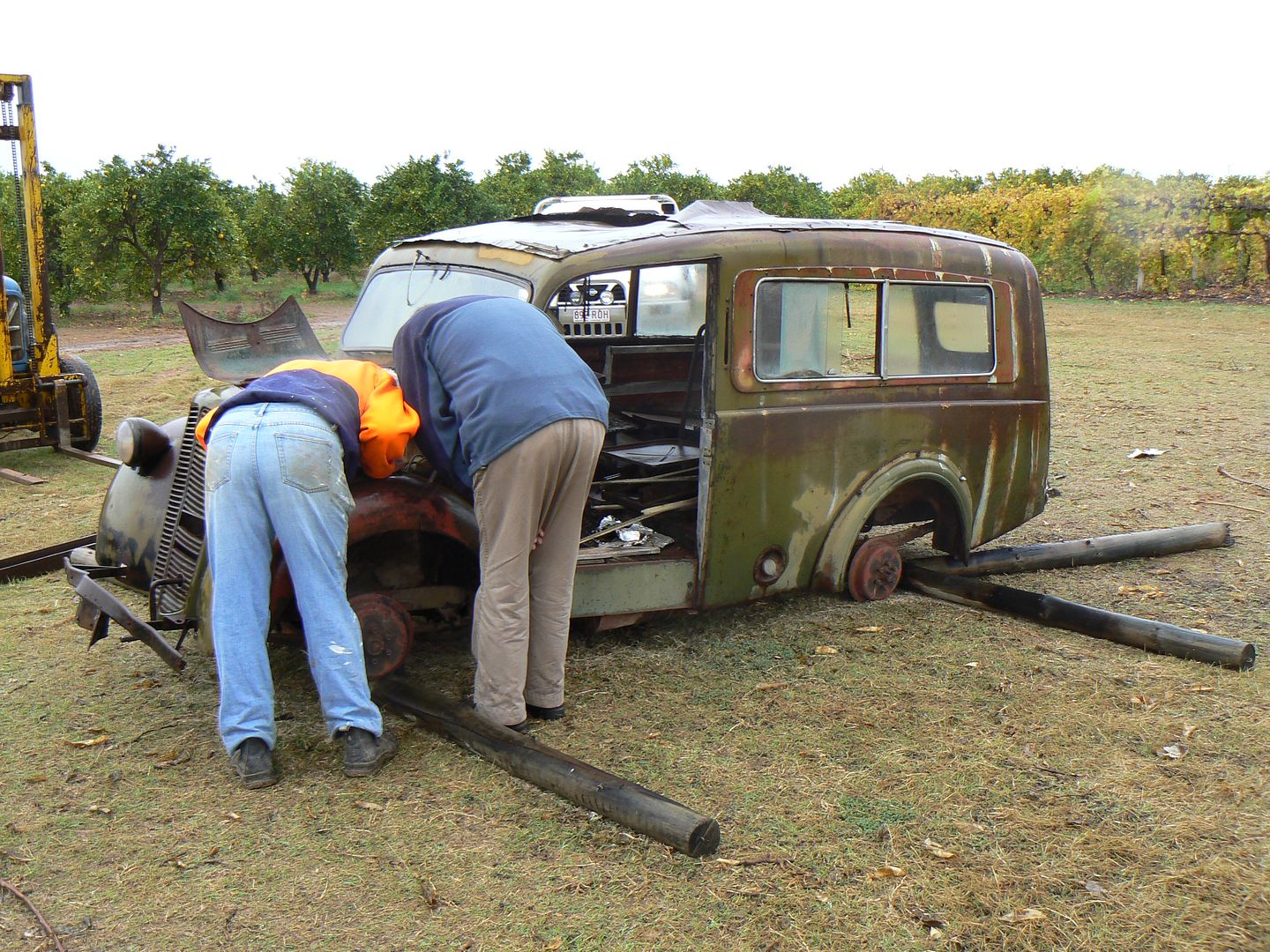 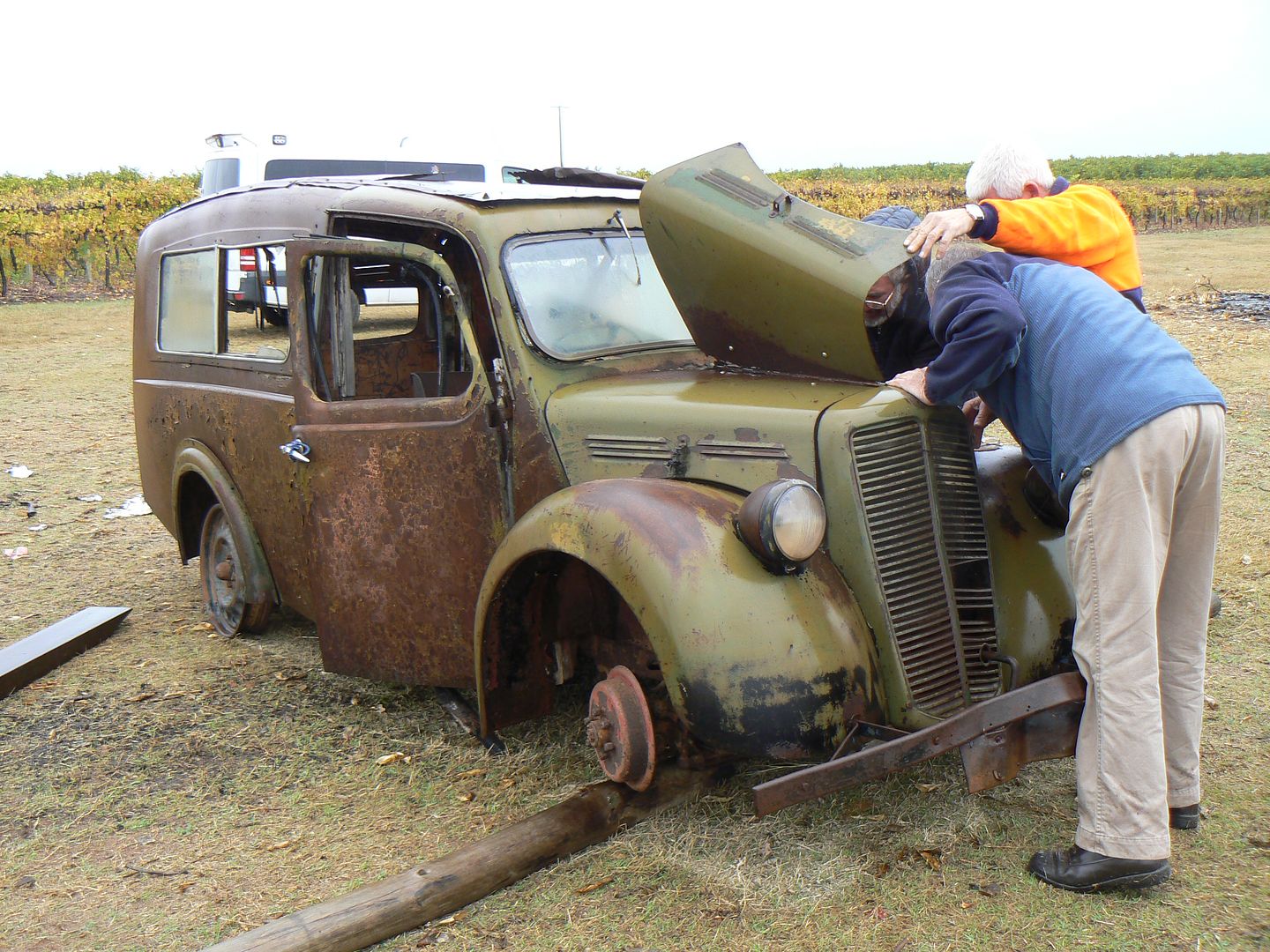 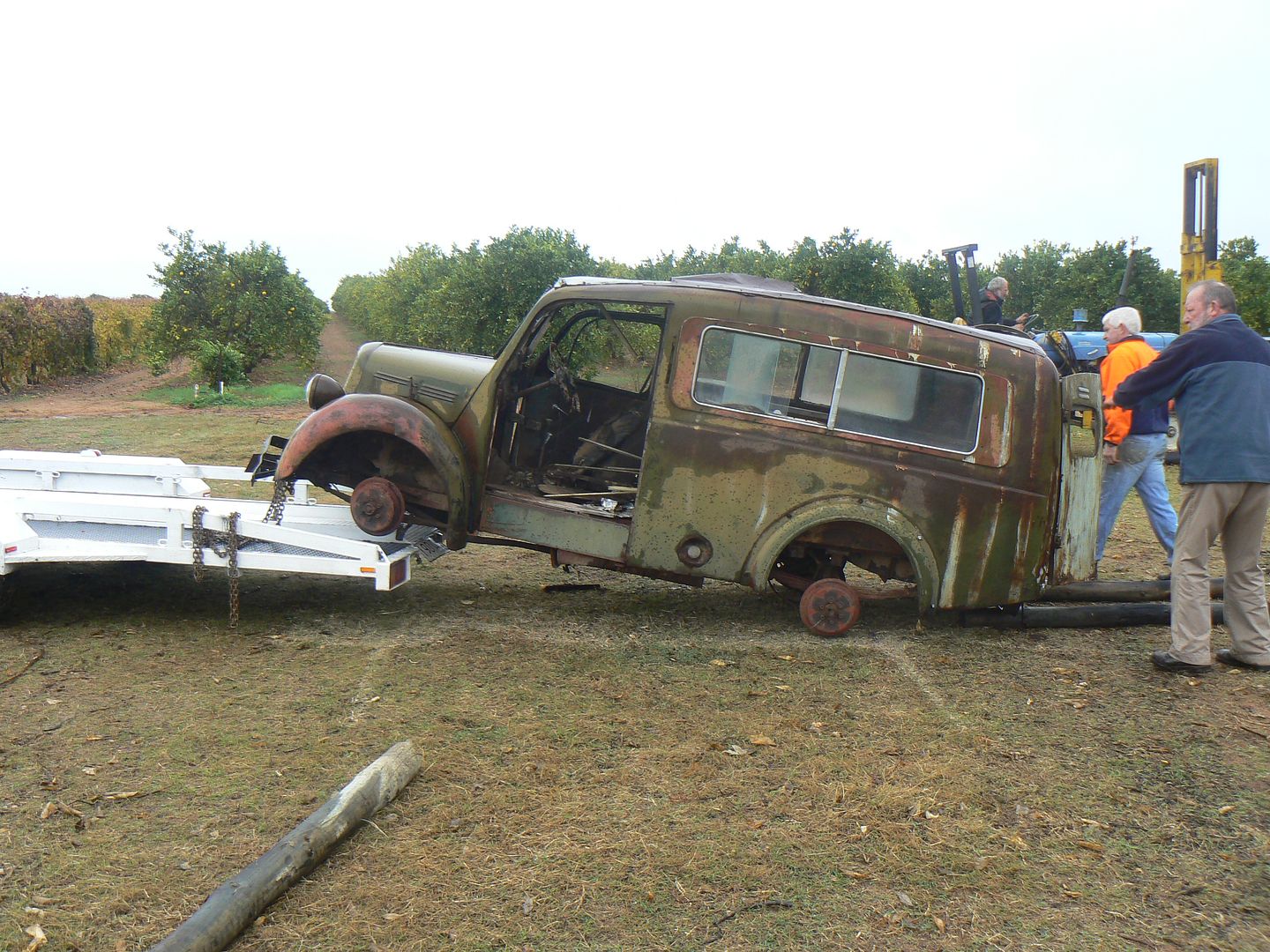 Lang Last edited by Lang; 25-05-13 at 08:41. |
|
#11
|
||||
|
||||
|
At least you have one original so you can identify them positively. I don't think I've ever seen one of those vans round here.
Are those side windows original, or at least contemporary?
__________________
Gordon, in Scotland |
|
#12
|
|||
|
|||
|
Getting more info.
The owner, aged 60, can remember this vehicle sitting in his older sister's yard in the late 50's looking "exactly the same condition as now" He has done some research for me and says it was "bought from an army auction right after the war". It was used by a family as their car and they are the ones who put the windows in. They are certainly not an amateur modification and look very professionally done. In the late 40's it was used commercially as a baker's van before being sold to the current family who only used it for a "few years" before parking and forgetting it. Photo of the Ford 10 which is an almost exact clone of the Morris (or vice versa) right down to the off-set engine. It shows this style of window was used during the period. Lang |
|
#13
|
||||
|
||||
|
I wonder if there was any wheel interchangeability with other contemporary makes, like the Ford ?
Might end up getting in four wheels from four different continents, but as long as you get there. It's not like not having the wheels is going to slow you down on the rest of it. I'm sure if any came up for sale someone in MLU-land would be willing to buy and post them on.
__________________
Gordon, in Scotland |
|
#14
|
||||
|
||||
|
Quote:
It is interesting to see the Ford photo, because I believe that is a Martin Walter Utilicon conversion (ie a personnel carrier). This company was in Folkestone, Kent and converted a huge number of van conversions over many years, largely on Bedfords latterly. Here is a link to another 12/4 van in Australia and looking at the engine number, is close to yours, pity your chassis number is not complete. It has the Martin Walter conversion, side windows slightly different, but would be interesting to see if the rear floor looks the same on yours. This one was apparently bought new. http://www.svvs.org/Utilevan.shtml I remember as a kid, the owner of the village shop had one of these van with windows in, and the Royal Mail used them as well. Still a few around and I was aghast recently when I saw one made in to a "hot rod", bet it did not have the wheezing side valve in it though ! regards, Richard
__________________
Richard 1943 Bedford QLD lorry - 1941 BSA WM20 m/cycle - 1943 Daimler Scout Car Mk2 Member of MVT, IMPS, MVG of NSW, KVE and AMVCS KVE President & KVE News Editor |
|
#15
|
||||
|
||||
|
Hi Lang,
Another website with a link to the owner of the other 12/4 van in Australia: http://www.iamo.org.uk/Restorations/...20Utilevan.htm regards, Richard
__________________
Richard 1943 Bedford QLD lorry - 1941 BSA WM20 m/cycle - 1943 Daimler Scout Car Mk2 Member of MVT, IMPS, MVG of NSW, KVE and AMVCS KVE President & KVE News Editor |
|
#16
|
|||
|
|||
|
Gordon,
I certainly would look at wheels from anywhere. 16" are readily available but 18"? Richard, Trying to track down the Australian Morris Y owner, If his details are correct it puts the whole story from my owner in doubt as the dates can't be reconciled. Lang Last edited by Lang; 25-05-13 at 12:01. |
|
#17
|
||||
|
||||
|
Lang,
Here is the owners email from my second link, imoretonAToptusnet.com.au ( remove AT and insert @)
__________________
Richard 1943 Bedford QLD lorry - 1941 BSA WM20 m/cycle - 1943 Daimler Scout Car Mk2 Member of MVT, IMPS, MVG of NSW, KVE and AMVCS KVE President & KVE News Editor |
|
#18
|
|||
|
|||
|
Lang,
Thanks for the data, but I have been unable to equate it with the very limited references I have to Morris vans in military service in Australia. Nevertheless, the records show some interesting things in the light of your find, and the posts above. The USAFIA returned a Morris 'Light English Utility' in Sydney for disposal by the CDC in late 1944. It had 17,660 miles on the clock. US Army registration number was USA-U-27167. No engine or chassis number given. The RAN list three possibles, all listed as still in service in the post-war period (late 1940s). They were operated from HMAS Harmon and the Belconnen Wireless Station, both near Canberra (The big wireless station @ Belconnen was for all international government messaging during and post-war. Now defunct and last I heard, awaiting dismantling of the huge tower). RAN registrations were: RAN 58259 ... eng number 65932) RAN 58258 ... eng number 66080) These appear to be in a wartime group. RAN 60191 ... eng number NPSC14042. This appears to be post-war: it's in a group that includes Holdens, etc. The first two, by coincidence, are described as 'Utilivans' which now means a lot more to me than when I first saw the term, thanks to these posts. The last is described as a 'Van'. The first two engine numbers are interesting in the light of yours (70203) which might indicate the RAN ones were earlier production? - doubtless our English friends with greater knowledge of Morris vehicle engine numbers can comment on that. IF the RAN ones were wartime, they would have been painted in KG3 as per the camouflage regulations, but possibly re-painted post war in either dark blue or seagrey. If similar vehicles had been disposed of by the RAN at war's end, then most likely in KG3 paint. HOWEVER, the RAN had an alarming propensity to re-issue registrations and migrate the plates to different vehicles once the original was disposed of. So, while it appears that these (above) are wartime registrations, this is not certain. Maybe the approx. production year can be ascertained from the engine numbers? Also, I don't have anywhere near a complete list of RAN registrations, so they may have had others I have not found a record of as yet (and which were disposed of at war's end?). Something else to consider - and this is just theorizing - I would expect that, if the Morris is wartime, then its production year should be pre-1942, rather than 1942 or later, as imports from the UK were restricted during the 1940-41 period (but still possible to import commercial type goods), then severely restricted from late 1941 onwards, with virtually no civilian MVs imported until the end of the war. I cannot see a few Morris vans being high on the governments import agenda during the 1942-1945 period, especially when there was an over-abundance of modified conventional vehicles already 'on the books'. The other (remote?) possibility is that these were Refugee Cargo, arriving in Oz in late 41/early 42, having been diverted while en route to English forces in Malaya, etc. They would have to be pre-42 build to be considered for that scenario. Hope this helps. Mike C |
|
#19
|
|||
|
|||
|
Mike,
Thanks for all that info. These are very interesting vehicles. Maybe a fourth possibility would be imported with returning Middle East vehicles? There were certainly some orphans came back with that lot and there were hundreds of small non-tactical vehicles running around Cairo. It would appear in all likelyhood, although production of these ran from 1939 that my vehicle is post war. I have had a good look at it and the paint is certainly military and done right up under dash and tight corners which is usually not the case with a respray - suppose there were thousands of gallons of excess army paint sold after the war so it would have been available. Why would anyone paint their new? car army green just after the war? The investigation proceeds! Lang |
|
#20
|
|||
|
|||
|
Lang,
Yes, I had considered the possibility of ex-Middle East, but a quick look through the data didn't show any evidence of such vehicles, so I more or less dismissed it as a credible source (they were mostly tactical trucks, tractors, etc) One I hadn't considered, however, was the build-up of Brit forces in Australia in 1945, preparatory to the invasion of Japan. Some logistics people were here, and had commenced to organize for an influx of more Brit personnel when the bomb got dropped and it was all over. Maybe this is a 'leave behind' from them? I'll be interested to know from our English friends if and how the engine numbers line up with production dates. Mike C |
|
#21
|
||||
|
||||
|
Quote:
In an old Lockheed brake catalogue it lists as follows; 12/4, 8/10cwt Van 1935 12hp, Series II, 10cwt Van, 1935-39 12hp, Van, Series Y, 10cwt, 1944 12hp, Van, Series Y, 10cwt, ARP, 1940 from this and other references I have found it looks like they were not known a Y types until in the 40's and your chassis plate has it as a 12/4 so looks to be prewar.
__________________
Richard 1943 Bedford QLD lorry - 1941 BSA WM20 m/cycle - 1943 Daimler Scout Car Mk2 Member of MVT, IMPS, MVG of NSW, KVE and AMVCS KVE President & KVE News Editor |
|
#22
|
|||
|
|||
|
Richard,
The owner was always insistent it was 1936 but this does not sit well with me. I wonder if the factory always designated the whole series 12/4 on the plates and the various model designations were marketing department inventions? I am awaiting an original manual which has on the cover Morris 10cwt, Series "Y" to see if there is reference to 12/4. Have a look at this info on the Morris 12/4. The mystery deepens! The 12/4 cars were only side valve until 1937. Would a van, not starting production until 1939 have been afflicted with a sidevalve from the past when everything coming down the line had overhead valve engines? http://www.iamo.org.uk/Models/Twelve...ies.htm#engine As a spoiler I have just found a Fordson E83 which we know was certainly in service but the lesser power (1,100cc) and atrocious top speed of 40mph knocks it out for any Normandy trip. The Morris advertising may actually be correct about speed and from various sources 12/4 is rated at 72mph top speed with its 1,500cc motor - not many small cars of that era could do any better than that. Lang Last edited by Lang; 26-05-13 at 02:44. |
|
#23
|
||||
|
||||
|
Quote:
The performance of the Morris surprises me, not so bad a choice after all. Those Ford E83W were still common in the early 60's and when I went to school, the meals were brought across from a nearby school kitchen by a local garage under contract. They had a open back Ford, and often a couple of extra people would be with it to push start it, always a scene of amusement!
__________________
Richard 1943 Bedford QLD lorry - 1941 BSA WM20 m/cycle - 1943 Daimler Scout Car Mk2 Member of MVT, IMPS, MVG of NSW, KVE and AMVCS KVE President & KVE News Editor |
|
#24
|
|||
|
|||
|
I think she would be a pretty wild old ride coming down the Swiss passes at that speed in a Morris van although the brakes are full hydraulic and the steering, shock absorbers etc seem well built and robust.
Here is some useful info on all the Morris commercial vehicles. http://www.iamo.org.uk/commdirectory.htm Lang |
|
#25
|
||||
|
||||
|
Quote:
I have just sent you a PM Richard
__________________
Richard 1943 Bedford QLD lorry - 1941 BSA WM20 m/cycle - 1943 Daimler Scout Car Mk2 Member of MVT, IMPS, MVG of NSW, KVE and AMVCS KVE President & KVE News Editor |
|
#26
|
|||
|
|||
|
Maybe this should be on a new thread but too valuable to not put up somewhere.
http://home.zonnet.nl/carclub.ij-v5/...Enginecode.pdf Even so it makes no sense to my Morris 12/4 SY/TWV 20???? Lang Last edited by Lang; 26-05-13 at 10:40. |
|
#27
|
|||
|
|||
|
Quote:
|
|
#28
|
|||
|
|||
|
|
|
#29
|
|||
|
|||
|
Yup, the ones I know of are different alright!!
|
|
#30
|
|||
|
|||
|
Very nice find Lang! Would love to see this in Normandy, next year.
Just saw a Morris wheel today, but even though it was similar in looks it had five studs in stead of six! Morris 10 according to the seller (?) Alex
__________________
Chevrolet C8 cab 11 FFW BSA Folding Bicycle |
 |
| Thread Tools | |
| Display Modes | |
|
|